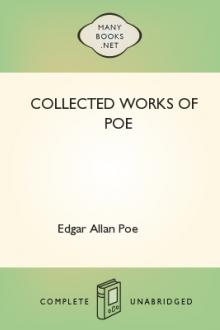The Works of Edgar Allan Poe — Volume 2, Edgar Allan Poe [read more books .txt] 📗

- Author: Edgar Allan Poe
Book online «The Works of Edgar Allan Poe — Volume 2, Edgar Allan Poe [read more books .txt] 📗». Author Edgar Allan Poe
The piazzas of the main building and western wing had no floors, as is usual; but at the doors and at each window, large, flat irregular slabs of granite lay imbedded in the delicious turf, affording comfortable footing in all weather. Excellent paths of the same material—not nicely adapted, but with the velvety sod filling frequent intervals between the stones, led hither and thither from the house, to a crystal spring about five paces off, to the road, or to one or two out-houses that lay to the north, beyond the brook, and were thoroughly concealed by a few locusts and catalpas.
Not more than six steps from the main door of the cottage stood the dead trunk of a fantastic pear-tree, so clothed from head to foot in the gorgeous bignonia blossoms that one required no little scrutiny to determine what manner of sweet thing it could be. From various arms of this tree hung cages of different kinds. In one, a large wicker cylinder with a ring at top, revelled a mocking bird; in another an oriole; in a third the impudent bobolink—while three or four more delicate prisons were loudly vocal with canaries.
The pillars of the piazza were enwreathed in jasmine and sweet honeysuckle; while from the angle formed by the main structure and its west wing, in front, sprang a grape-vine of unexampled luxuriance. Scorning all restraint, it had clambered first to the lower roof—then to the higher; and along the ridge of this latter it continued to writhe on, throwing out tendrils to the right and left, until at length it fairly attained the east gable, and fell trailing over the stairs.
The whole house, with its wings, was constructed of the old-fashioned Dutch shingles—broad, and with unrounded corners. It is a peculiarity of this material to give houses built of it the appearance of being wider at bottom than at top—after the manner of Egyptian architecture; and in the present instance, this exceedingly picturesque effect was aided by numerous pots of gorgeous flowers that almost encompassed the base of the buildings.
The shingles were painted a dull gray; and the happiness with which this neutral tint melted into the vivid green of the tulip tree leaves that partially overshadowed the cottage, can readily be conceived by an artist.
From the position near the stone wall, as described, the buildings were seen at great advantage—for the southeastern angle was thrown forward—so that the eye took in at once the whole of the two fronts, with the picturesque eastern gable, and at the same time obtained just a sufficient glimpse of the northern wing, with parts of a pretty roof to the spring-house, and nearly half of a light bridge that spanned the brook in the near vicinity of the main buildings.
I did not remain very long on the brow of the hill, although long enough to make a thorough survey of the scene at my feet. It was clear that I had wandered from the road to the village, and I had thus good traveller’s excuse to open the gate before me, and inquire my way, at all events; so, without more ado, I proceeded.
The road, after passing the gate, seemed to lie upon a natural ledge, sloping gradually down along the face of the north-eastern cliffs. It led me on to the foot of the northern precipice, and thence over the bridge, round by the eastern gable to the front door. In this progress, I took notice that no sight of the out-houses could be obtained.
As I turned the corner of the gable, the mastiff bounded towards me in stern silence, but with the eye and the whole air of a tiger. I held him out my hand, however, in token of amity—and I never yet knew the dog who was proof against such an appeal to his courtesy. He not only shut his mouth and wagged his tail, but absolutely offered me his paw—afterward extending his civilities to Ponto.
As no bell was discernible, I rapped with my stick against the door, which stood half open. Instantly a figure advanced to the threshold—that of a young woman about twenty-eight years of age—slender, or rather slight, and somewhat above the medium height. As she approached, with a certain modest decision of step altogether indescribable. I said to myself, “Surely here I have found the perfection of natural, in contradistinction from artificial grace.” The second impression which she made on me, but by far the more vivid of the two, was that of enthusiasm. So intense an expression of romance, perhaps I should call it, or of unworldliness, as that which gleamed from her deep-set eyes, had never so sunk into my heart of hearts before. I know not how it is, but this peculiar expression of the eye, wreathing itself occasionally into the lips, is the most powerful, if not absolutely the sole spell, which rivets my interest in woman. “Romance,” provided my readers fully comprehended what I would here imply by the word—“romance” and “womanliness” seem to me convertible terms: and, after all, what man truly loves in woman, is simply her womanhood. The eyes of Annie (I heard some one from the interior call her “Annie, darling!”) were “spiritual grey;” her hair, a light chestnut: this is all I had time to observe of her.
At her most courteous of invitations, I entered—passing first into a tolerably wide vestibule. Having come mainly to observe, I took notice that to my right as I stepped in, was a window, such as those in front of the house; to the left, a door leading into the principal room; while, opposite me, an open door enabled me to see a small apartment, just the size of the vestibule, arranged as a study, and having a large bow window looking out to the north.
Passing into the parlor, I found myself with Mr. Landor—for this, I afterwards found, was his name. He was civil, even cordial in his manner, but just then, I was more intent on observing the arrangements of the dwelling which had so much interested me, than the personal appearance of the tenant.
The north wing, I now saw, was a bed-chamber, its door opened into the parlor. West of this door was a single window, looking toward the brook. At the west end of the parlor, were a fireplace, and a door leading into the west wing—probably a kitchen.
Nothing could be more rigorously simple than the furniture of the parlor. On the floor was an ingrain carpet, of excellent texture—a white ground, spotted with small circular green figures. At the windows were curtains of snowy white jaconet muslin: they were tolerably full, and hung decisively, perhaps rather formally in sharp, parallel plaits to the floor—just to the floor. The walls were prepared with a French paper of great delicacy, a silver ground, with a faint green cord running zig-zag throughout. Its expanse was relieved merely by three of Julien’s exquisite lithographs a trois crayons, fastened to the wall without frames. One of these drawings was a scene of Oriental luxury, or rather voluptuousness; another was a “carnival piece,” spirited beyond compare; the third was a Greek female head—a face so divinely beautiful, and yet of an expression so provokingly indeterminate, never before arrested my attention.
The more substantial furniture consisted of a round table, a few chairs (including a large rocking-chair), and a sofa, or rather “settee;” its material was plain maple painted a creamy white, slightly interstriped with green; the seat of cane. The chairs and





Comments (0)